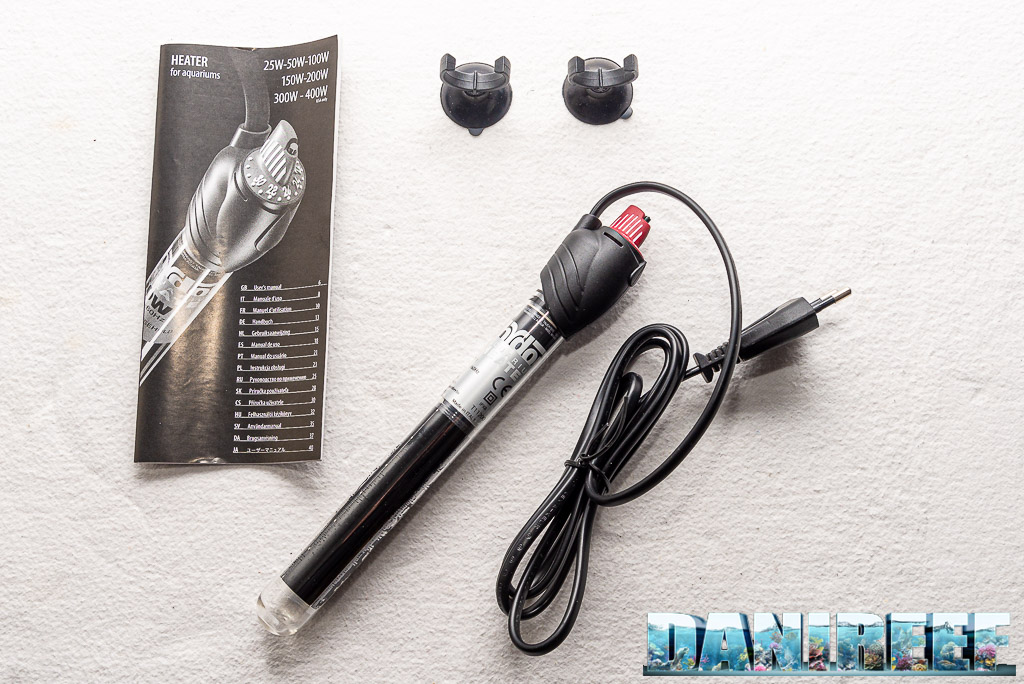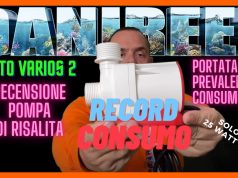
We got to try the Hydor Theo 100-watt heater in our nanoreef and we fell in love with it. Let’s see why in our review.
This article is also available in: Italiano
This new heater is very interesting because of its small size and especially because of the PTC film that provides automatic control of overtemperatures by going to limit the power in case irregular operation is detected. At this point, thanks to the carbon aggregates moving away from each other, thus leading to an increase in resistance, the Hydor Theo heater will independently shut down.
The construction is unbreakable glass, so we will not even have to worry, much, about the possibility of breaking it. That together with the PTC film already mentioned makes it virtually indestructible, not only unbreakable but also resistant to overheating. Explaining it in a simple way, in case it is left without water, thanks to the carbon aggregates inside the device, which by moving away would decrease the passage of current, the heater would limit its power, but coming back ready as soon as external conditions allow it
Technical specifications Hydor Theo 100 watt heater
- Unbreakable glass;
- Use of PTC film for temperature control;
- Temperature setting dial from 20 to 32°;
- Italian plug;
- 100 watt consumption;
- Recommended by Hydor for aquariums from 50 to 100 liters;
- Compatible with freshwater and saltwater;
- Fully submersible;
- Monitoring light;
- Diameter 3 cm;
- Length 22.6 cm.

Our video on the 100-watt Hydor Theo heater
As usual, we also made our own video to explain better and in words the features of the new Hydor Theo heater, don’t miss it! The video has italian language, but you can select subtitle and then translating into english.
The Hydor Theo range and how to choose the right heater
Hydor, as we mentioned in our video, has created the new Theo range to cater to most aquarists, and in fact the heater exists in 25, 50, 100, 150, 200 and 300 watt sizes. There is also a 400 watt version in the United States, which I am not currently aware of being marketed in Italy.

Under normal conditions, like aquarium housed in our home and not in unheated places, such as a basement, it is sufficient to buy the heater with power similar to the gross volume of the tank. In my case I have an 80 liters nanoreef and I got the 100-watt Theo. This is valid for virtually any combination of fish, plants, corals, freshwater or marine aquariums. The only exception is Discus that want very warm aquariums, and for which I would advise you to choose the heater so that it has at least twice as many watts as the volume of the tank. For example, I would get two 200 watt heaters for a 100-liter Discus specific aquarium.

The convenience of this heater lies in the fact that it can be placed in the aquarium either vertically or completely submerged, an ideal situation especially for marine aquariums that can place the heater inside the sump instead of directly in the tank. For freshwater aquariums, on the other hand, you can place the heater vertically beside the internal filter or in a corner. To do this, there are 2 special suction cups supplied that have a hook with 3 raised points to hold the heater in place.

This way not all the plastic adheres, which would be heated, but it increases even if slightly the overall efficiency. These are details, mind you, but we like them in no small way. They denote care of the product.
How to set the temperature in aquarium
To set the temperature, you can use the upper red dial that has the numbers of the temperature you want to keep in the aquarium printed large.

The scale ranges from a minimum of 20 degrees to a maximum of 32 degrees. You have to set the number on the black “drop” located just below the numbers. The dial turns easily and without any play.
We proceeded to measure the power consumption, as you can see in the video, and measured about 96 watts with a cos(fi) of 0.99. Basically all the electrical energy is converted to heat. And the consumption, net of voltage differences, we can consider it to be coincident with what Hydor stated.
Let’s sum up
We liked the Hydor Theo 100 watt heater. Small, handy, but unbreakable and with overheating protection make it a great heater for our aquarium. The only caution is to choose it of the right wattage.
Because remember, the right heater is the one that, on the coldest days of the year, never goes out!
The full explanation can be found in the video, but trivially the concept is that during the day there should not be continuous temperature changes.
The 100-watt Hydor Theo heater costs 30.5 euros, but it can be found much cheaper on the street, such as on Amazon (click here). A price we consider more than adequate for the class of this heater.

PROS
![]() Unbreakable;
Unbreakable;![]() Does not suffer from staying dry (overtemperature protection);
Does not suffer from staying dry (overtemperature protection);![]() Small and handy;
Small and handy;![]() Italian plug;
Italian plug;
CONS
![]() Nothing relevant.
Nothing relevant.
Hydor Theo 100 watt heater – summary table
Thanks to Hydor for sending the 100-watt Theo heater in order to conduct this review.














